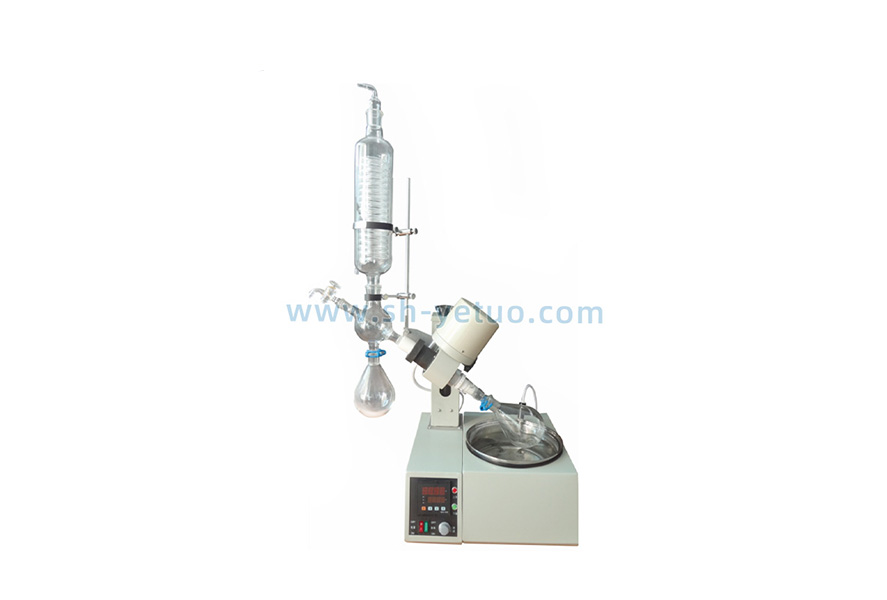The Shanghai Yetuo rotary evaporator is a basic equipment widely used in laboratories for solvent evaporation, sample concentration, and recovery, especially playing an important role in fields such as chemistry, organic synthesis, biopharmaceuticals, and food testing. A correct understanding of its working principle and operating specifications can help improve experimental efficiency and avoid equipment failures and overall risks.
1、 Working principle
The core working principle of the rotary evaporator is to form a thin film of liquid and accelerate evaporation by rotating the evaporator bottle under reduced pressure, and then recover the solvent through condensation. It mainly consists of the following key systems:
1. Heating system: usually a water bath or oil bath, providing a stable heat source to evaporate the solvent upon heating. In a vacuum environment, the boiling point of the solvent decreases, allowing for rapid evaporation at lower temperatures and protecting thermosensitive substances.
2. Rotating system: The evaporation bottle is driven by a motor to rotate, causing the liquid to adhere to the bottle wall and form a thin film, increasing the evaporation area and improving the evaporation efficiency, while avoiding local overheating or "boiling".
3. Vacuum system: An external vacuum pump is used to reduce the system pressure to the target level, lower the boiling point of the solvent, and achieve rapid evaporation. Common vacuum pumps include water ring pumps, diaphragm pumps, etc.
4. Condensation system: The evaporated gaseous solvent is cooled through a condenser tube and liquefied before flowing into a recovery bottle, with a recovery rate typically above 90%. The condensing medium is mostly circulating cooling water or coolant.
Overall process: The liquid rotates and heats up inside the evaporation bottle → evaporates rapidly under low pressure → the steam enters the condenser → is cooled and liquefied → the solvent is recovered.
2、 Operation precautions
1. Check the connection and sealing of the equipment
Before operation, check whether all glass interfaces of the rotary evaporator are securely installed and apply an appropriate amount of vacuum silicone grease to ensure good system sealing. Connect the vacuum pump to the cooling cycle and confirm that there is no air leakage.
2. Set reasonable heating temperature and vacuum degree
According to the boiling points of different solvents, set the appropriate water bath temperature (usually about 20 ℃ higher than the boiling point of the solvent), and adjust the vacuum pump to stabilize the system pressure. Avoid boiling due to high temperature or low vacuum.
3. Control the speed to prevent sample splashing
Reasonably set the rotation speed (usually 50-120 rpm), and the sample liquid level should not be too high to avoid liquid splashing onto the condenser tube, affecting recovery efficiency or contaminating the system.
4. The condensation system needs to be started first
The operation sequence is: turn on the cooling water → start the vacuum pump → heat the water bath → start the rotating motor. Start the condensation system first to prevent abnormal system pressure caused by the inability of steam to condense.
5. After the operation is completed, uninstall correctly
After the experiment is completed, the heating and rotation should be stopped first, and the water bath should be cooled down before turning off the vacuum pump and slowly introducing air to relieve negative pressure. Remove the evaporation bottle and recycling bottle, and clean them thoroughly.
6. Daily maintenance and cleaning
Regularly inspect the sealing ring, glass components, and motor operation. Avoid strong alkali and acid during cleaning, use cleaning solution to keep the pipeline and bottle transparent and clean.
The operation of Shanghai Yetuo rotary evaporator relies on a deep understanding of the working principle and strict control of operational details. Following standards not only extends the service life of equipment, but also ensures the accuracy of experimental data and the safety of laboratory personnel, which is a basic skill mastered by every laboratory operator.


 Alibaba Store
Alibaba Store Tmall Store
Tmall Store Jingdong Sstore
Jingdong Sstore







